Creating eBay Variation Listings
Last updated: 2020-10-03 (work in progress)
External Resources:
- Quick Guide
- Variation Categories
- eBay Variation Help page
- Variation Spreadsheet builder
- Stock Control help
- Photo Compositor
About Variations
A variation listing allows grouping and selling items that are nearly identical and are similarly priced, but that differ in minor details like size, color, or pattern. At the top of a listing, variations look like dropdown lists of options that might bring up different photos and different prices.
Within eBay's listing form, the dropdown group is called the Attribute and the items within each droplist are called Options. In the image below, there are two "Attributes" called "colors" and "shape". Within the "shape" group are Options called "oval", "square", and "round". Within a multi-variation listing, two or more Options can be chosen to select a Combination or variation item.
Because the words "Attribute" and "Option" don't sink in very well, I'll try to use more words around each one when describing them. The Attribute is the name of the group and the Options are the values within each group.
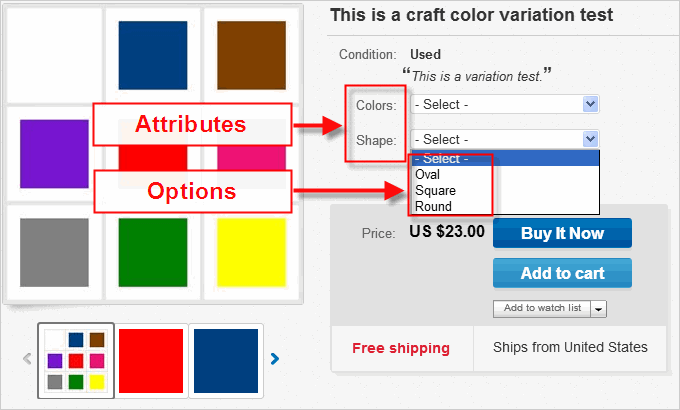
The variation lingo is mixed on different eBay pages, so here's another look at what they mean:
• Attribute = Trait = Variation = selection group (like: size or color).
• Options = values = drop list items (like: small, medium, large or red, green, blue).
• Combination = variation item (like: small red or large blue).
What you get
eBay allows up to 5 Attributes or groups and up to 60 Options within each group in most of the supported categories. That means there could be up to 5 dropdown lists on a listing with scads of Options within each one. While that adds up to a whopping 300 variation items, in reality, eBay allows only 250 Combinations or variation items in one listing. eBay will treat each variation Combination as a separate item in your search count, but you will be billed only one insertion for the one listing, so variations are an excellent way to hold down insertion fees while increasing positive exposure. If a buyer enters one of your variation options in a search, like looking for a "red" version of that item, then your "red" variation item will appear in their search instead of your default view.
While a standard listing allows 12 free photos, a variation listing allows the same 12 default photos and can also attach 12 photos to each of the Options within one Attribute (within only one variation group). So if one Attribute can hold up to 60 Options, you would be allowed 60x12 photos in that Attribute group. You'll have to choose which group will determine the photos, and typically that will be a group with visible differences, like color. If there are no visible differences between the Options, then the default photo group would be adequate.
Some Considerations
Buyers may select multiple quantities of a single variation Combination, but will be unable to purchase different variation Combinations in one "buy now" step. However, buyers can add those different variations to the shopping cart and can then purchase all items as one transaction during checkout.
Variation listings are unable to support "best offer" at this time.
Your variation Combinations may incur different shipping costs due to differences in size or weight. One solution is to offer free shipping and to place the cost adjustment in the item price, or use flat or calculated shipping with an adder for excess shipping built into the price of the heavier items.
Some categories, like clothing, allow only 4 Attributes, but can accept more than 60 Options, as long as the total Combinations do not exceed 250 items.
Have more Options than allowed in one group? Consider a complex option group that breaks them into yet another grouping (see notes on complex grouping at end). Upper limit of 250 still applies.
Start with the correct listing form
To start a variation listing, you must create the listing from scratch and you must use the Advanced (business) listing form, not the Quick Lister, and not the Mobile App. You can not revise a listing to change it into a variation or sell-similar to create a variation — you must initially launch the listing as a variation. However, if you have an existing listing, you can edit and save with no revisions, and the "success" screen, after saving, will provide the option to "save as template". That saved template will then allow you to add variations to the new template, from which you can create your new variation listing.
The screenshots on this page are from the April 2019 Seller Hub listing form, using a narrower browser width. The form may format differently at different screen widths.
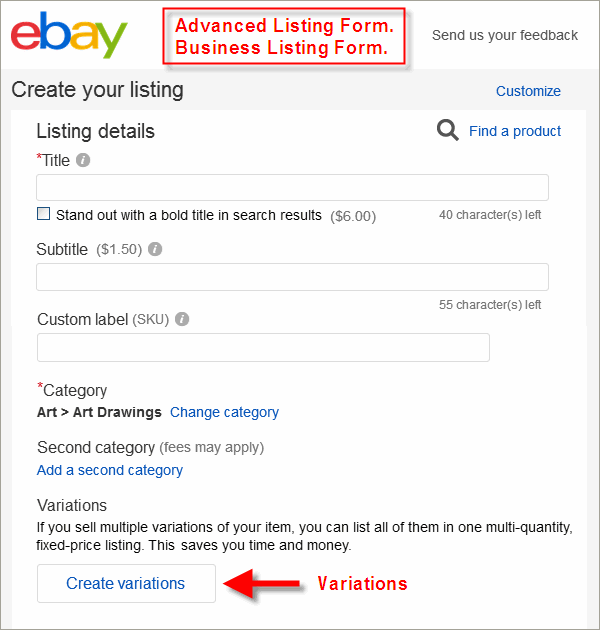
First, find the correct category for your listing and determine if that category supports variations. If a category is supported, you will see the "Create variation" button near the top of the listing form, just below the category selection. If variations are supported, then lay the groundwork first because you will be putting some effort into the listing form. Note: be sure your listing form is set to "fixed price" format and not "auction" format, since variations are not supported at all in auction format listings.
Gather photos
Prepare all the variation photos before starting. You'll want a set of common photos for the "default" or "unselected" landing page view. You can use the default photos for all of the variations if there are no visible differences in them, or you can set up your variations so that different photos are used for each Option in your one chosen Attribute group. It is possible that some Combinations might share the same photo.
When adding variation photos, only one Attribute group can determine photos. So if you have Attribute groups for color, size, and pattern, the photos might be based on color, for example, and not on size or pattern. Alternatively, you may decide that two Attributes should be combined because showing color and pattern variation is important. To do that, instead of solids and stripes as "pattern" Options, you might eliminate the "pattern" Attribute and include the patterns with your color Options, like blue-solid, blue-stripe, red-solid, red-stripe, and so forth. This is why setting up your photos and groups ahead of time is important.
If you want to show all variations in one photo, the online photostitch tool could be helpful:
http://zippyhelp.com/imagetools/stitch/photostitch.htm
Smaller source photos are acceptable for stitching because the combined size will usually exceed eBay requirements.
Determine your groups
Before starting, decide how you want to group your variations. You can have up to five Attribute groups, but most sellers use only a couple. Do you want to divide the items by color, size, style, shape, material, theme, season, compatibility? Choose the most important distinguishing feature and define that as your first variation Attribute.
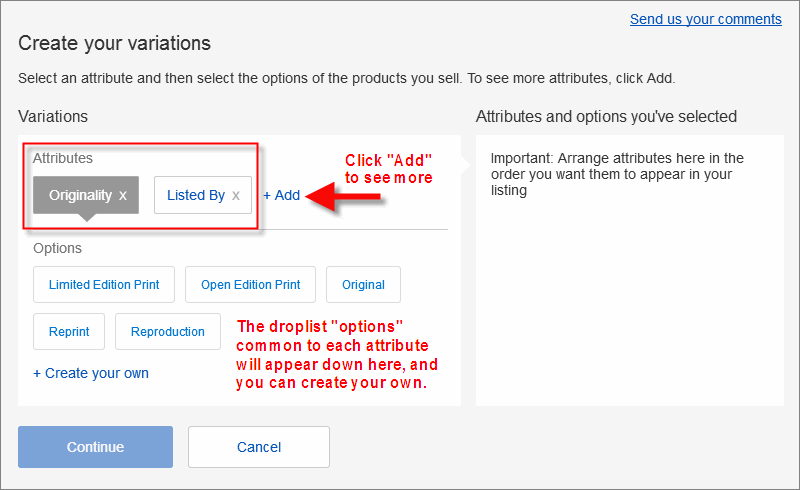
The variation tool will offer the most commonly used Attribute groups for your chosen category, with an "+Add" popover to select any others (above), or you can define your own Attribute. Simply "x" out or uncheckmark any that appear on your workspace that you don't want. You can see in my selections that I have unchecked "originality" and "Listed By" (above) and have selected "Size" and "Color" (below) instead. (Note that "color" may be reserved for the master record in some categories. If your group name conflicts with a mandatory master record name, modify the group name a bit, as in "colors" instead of "color".)
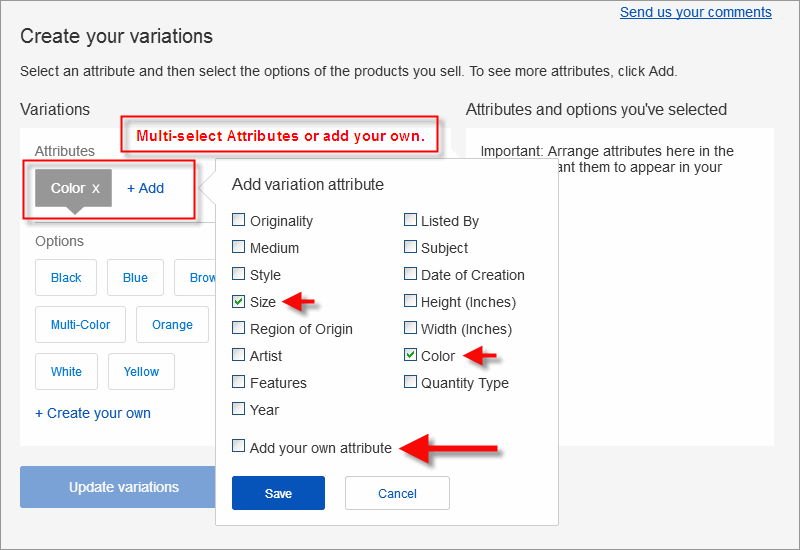
When adding each Attribute, you will see "Options" appear as buttons underneath. In the two screenshots above, you can see how the available Options differ for each Attribute group. When all Attributes are added, click through each Attribute to see the most commonly provided Option values for each Attribute. You can then select Options from those shown, or you can "+Create your own" if you don't see a match and then click "Add" after entering your Option name in the slot. Selected "Options" darken in color and are simply toggled on or off as needed.
For instance, if you decide that color is an important Attribute, create that Attribute and then select as many colors as you need, up to a maximum of 60 colors (Option values) for that Attribute. If the value you want is not there, like "metallic blue", you can click "+create your own" and add that value to your list. If you need more than 60 attributes, read about complex multi-variations near the end of this page before proceeding.
After you have chosen all of your variation Attributes and have added the list of Option values for each, everything can be rearranged and reordered in the right panel where you will see up/down arrows for the Attributes and where the Option values can be dragged left or right (shown below).
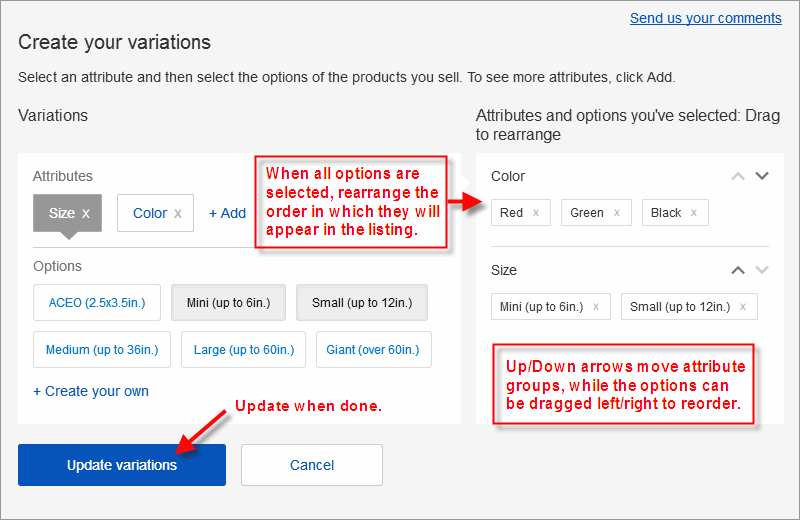
Editing to change the variation Attributes will reset other variation content, so get this section settled before moving on to the variation details. When returning to make substantial changes like adding or deleting Attributes (renaming is not an Option) the detail grid will be cleared of some values. You'll see the warning message below when saving after Attributes were added or deleted.

You will be allowed to return and add or remove Options from existing Attributes, or to rearrange your display order, without upsetting your variation details. A simpler message will appear after adding or deleting only Options.

Variation Photos
Once the Attributes and their Options are loaded, it is time to add photos and item details. While still in variation mode, eBay will display the photo uploading tool. That is where you can add and rearrange the default photos that will apply to all items in the listing. The default photos will display to the visitor before any Options have been selected.
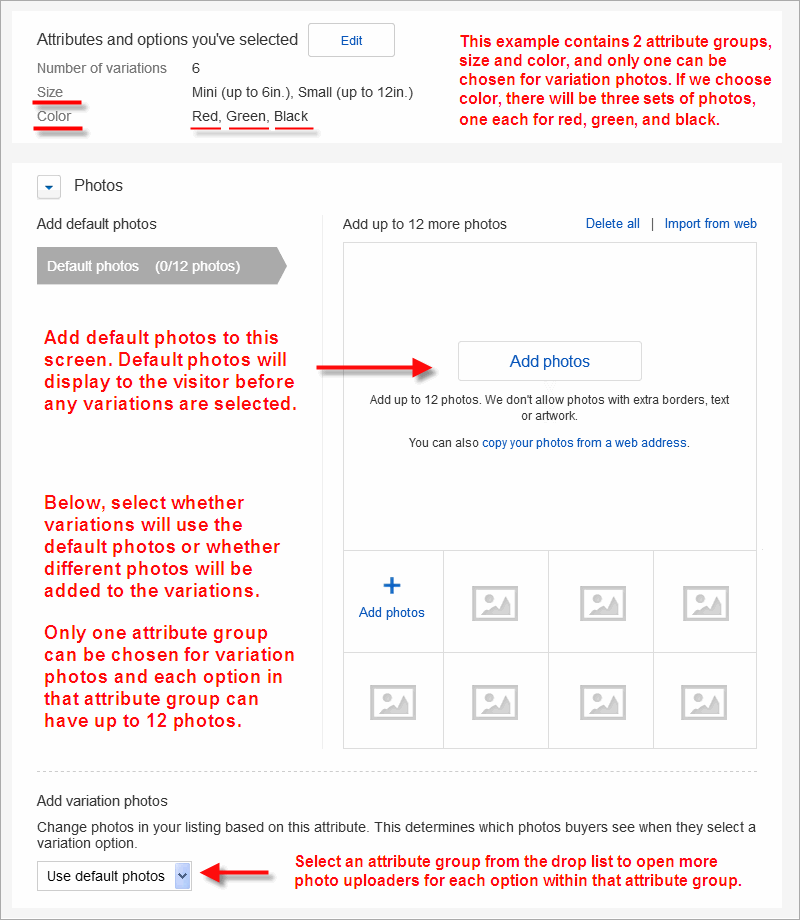
Underneath the default photo uploader is a droplist to select photos for the variations. You can choose to use the default photos for all variations or you can select one of your Attribute groups from the droplist in order to add variation photos. If choosing an Attribute group, a fresh uploader will appear. Select each Option in your chosen Attribute group and upload photos for each of those Options.
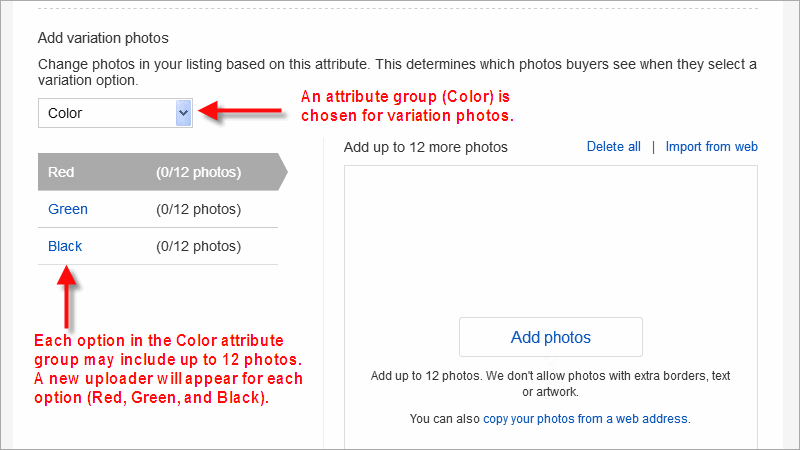
Variation Details
Further down on the same variation screen is a grid for populating variation details. Each variation item (one for every Combination of Attribute and Option) will be laid out in grid format so that you can quickly add the item details that might differ for each variation, like price, quantity, SKU, or UPC. The common details will still be entered on the main listing screen. There are two ways to add the variation details: type each one directly into the grid, or checkmark the boxes on the rows, click a button above, and enter a common value that will be added to each checkmarked row.
IMPORTANT! Any row that is populated with zero quantity will be removed from the variation list when launched, unless stock control is turned on.
So don't make the mistake of putting considerable work into your variation creation, only to have your items wiped out when you launch the listing!
With stock control activated, the item will show out of stock and will be either invisible or unselectable by the visitor.
If necessary, you can actually open a new browser tab and turn on stock control prior to completing your listing,
and stock control will then be applied to all existing listings, and to the one being created when it is launched.
Or you can save as draft and return to the draft after stock control is activated.
Stock Control Help
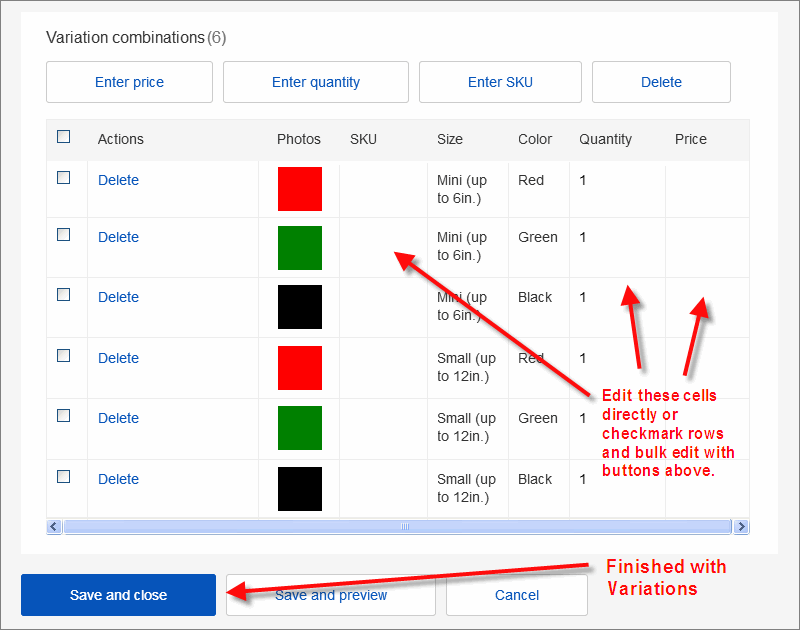
(The SKU shown above is for your own inventory control and is not a required field.)
When variation details have been populated for every Combination, the variation creation is finished. You may close and return to the main listing editor to add the remaining details that are common to all variations and to the listing.
Complete your listing
When returning to the main listing form, your default photos will be visible and you'll see a few new features associated with variations, including links to edit your variations. With the variations completed, you'll now be able to add the item specifics that are common to all items in the listing. Add your description and complete the rest of the form fields, preview as needed, and then launch the listing. Note: eBay disables clickable links on the popup preview, so you won't be able to test the dropdown lists in your variations.
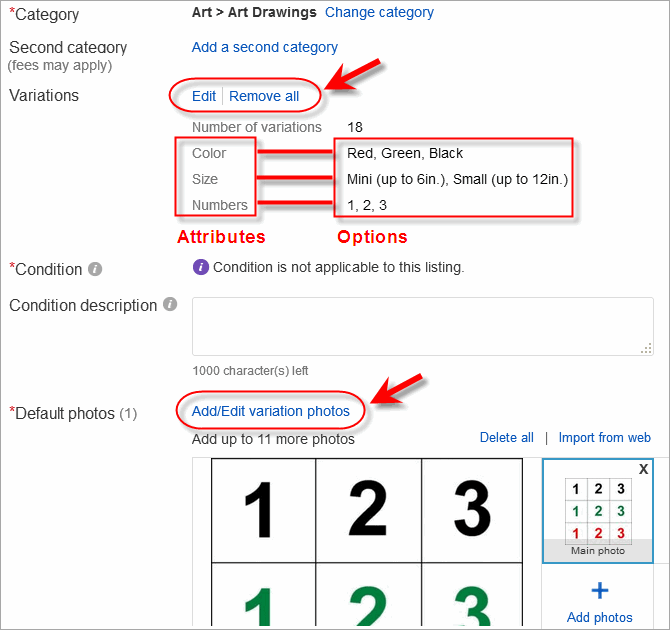
Revising an Active Variation Listing
The basic fields in an active variation listing can be revised like any other, and the variations should not be affected. However, if the variations also require revision, there are some steps to take.
When revising variations, use either one of the "edit" links circled in the above image. They will both take you to the same screen that starts with variation photos and ends with the Combination grid shown below. Anything can be changed on this screen without any serious issues, with the exception of quantity. If you do not have the Out-of-Stock control enabled and set a quantity to zero, or if a sale sets a quantity to zero, that Combination will be removed from the variation Combinations. However, it can be restored by using the "Add Combination" button at the top of the grid. Use that button to open a blue row that can only plug in the missing Combinations. It can't create new Combinations. Click Save on the blue row. When no more missing gaps are available, the button and blue row will no longer appear. So if you don't see the "Add Combination" button, your grid is fully populated with all available Combinations.
Adding/Removing Combinations: Combinations can be added or removed without consequence on this screen. [?????? If a combination has had a sale, it can't be removed until the sale ages off. ?????? Verify which statement is true ]
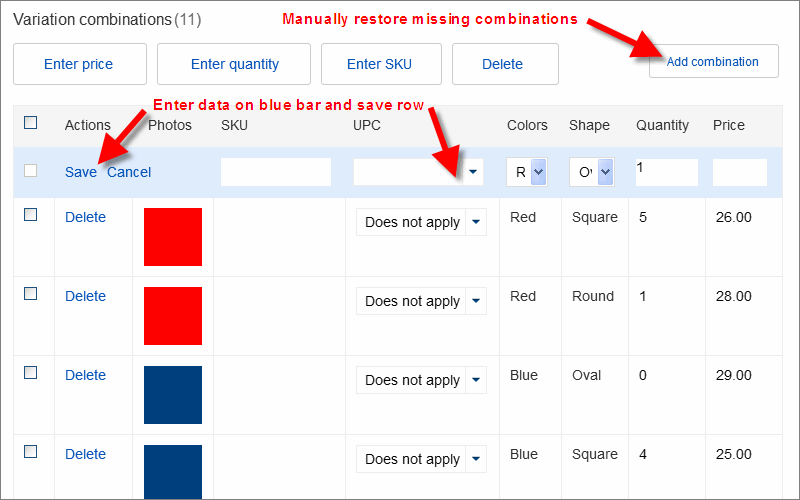
Sellers sometimes decide that their variations could have better names, but the system does not allow renaming. Instead, the only method is to create a new Attribute or Option and delete the old one. But that may carry consequences.

To add more variation Attributes or more variation Options, use the Edit button above the photos to get into the serious issues — the Attributes and Options.
Adding/Removing Options: You may add more Options to an existing Attribute group, or you can delete Options you no longer want within an Attribute. These changes will only affect specific Combinations and not the entire grid of details. When you add new Options to an Attribute, you'll need to later populate their details in the grid, and will be asked whether to allow the tool to automatically add them (simplest) or to add them yourself, which is probably only worthwhile if you don't want the entire Combination group added and only want a few items added.

Adding/Removing Attributes: Modifying Attributes is more complex, so the system may clear out your grid details (price, sku, quantity, upc, etc) when an Attribute is added or deleted. If you let the system automatically generate all the new Combination rows, the grid details will be reset or removed. If you choose to manually populate those new rows, the data from your prior fields will remain intact, and you would click the blue row to manually add and populate each newly added Combination.
If you plan to add or remove an Attribute group, you may want to first screencapture or print out the data that is already populating your Combination grid in case you may need to manually re-enter that data. Backups are never wasted.

Save and Preview
Although the preview option is offered, eBay's preview has disabled all clickable links. This means you might see the Attribute groups as separate drop lists, but you won't be able to open each list to see if it is correctly populated with options or if the combinations link to the correct photos. You'll have to complete your edits and post the listing to review the functionality.
Scheduling a listing out a few weeks, and then submitting it, has the advantage of putting the listing into a realistic setting without actually making it visible to the public. A scheduled listing can be reviewed and edited during the waiting period. When ready to publish, remove the schedule and submit. Or, instead, if the scheduled listing is no longer wanted, it can be ended without incurring insertion fees.
Complex Multi-variations
Some categories may warrant an option list that exceeds the 60 or more limit for Options within one Attribute group. This limit can be overcome by breaking similar options into further groupings.
For instance, suppose the variation Attributes for cables are "Length" and "Compatible Model", but there are 140 models. Add an Attribute called "Compatible Brand" and place the attributes in the order they should appear: "Length", "Compatible Brand", and "Compatible Model". Add the brand names as Options to the "Compatible Brand" Attribute. Then add all 140 model Options to the "Compatible Model" Attribute. Similarly, a seller might have 200 colors of paint, delivered in different tube sizes. The first Attribute might be "Size". Create another Attribute called "Color Family", with options like "Reds", "Blues", "Greens", etc. Then in the "Actual Color" Attribute, list all 200 colors. [??? It is not clear to me whether this list of 200 items can be selected for photos, or whether a limit of 60 photo sets applies ???] The possible combinations will far exceed the 250 combination limit (hundreds or thousands will be created). However, when making up the multi-combinations, apply only the correct model to each appropriate brand (or only the appropriate color to each color family) and skip those that don't match, thus limiting your overall combinations to 250 or fewer. Depending on the number of possible combinations, when presented with the decision to build, decide whether it is easier to auto-generate them all and then delete the unwanted ones, or whether it is easier to manually generate the far smaller subset of all combinations. Both methods are described earlier. Large sets of Combinations may be more expeditiously handled through a spreadsheet uploaded to eBay's File Exchange with the Variation Builder generating the combinations for the spreadsheet.File Exchange
subscribe
resources
forum
Add Variations from a Spreadsheet
File Exchange is a free eBay service that allows sellers to upload listings generated through spreadsheets.
There is a learning curve because the terminology and formatting are very precise,
but many find that using a spreadsheet speeds bulk listing creation.
We will only describe the method for including variations in the File Exchange spreadsheet and will assume the seller is already familiar with the basics.
If learning File Exchange, first successfully upload a single item listing before attempting a variation listing.
Each row in a File Exchange spreadsheet represents a single item. That row is called the "Item row". The exception occurs with "relationships". When a relationship column carries a value, subsequent columns are used to describe the relationship, such as a variation attached to the item. As with the standard listing form, all of the common data will populate the "Item row", while the specifics for each Combination with appear on separate "Variation rows".
| Action | Category | Relationship | RelationshipDetails | Product:UPC | Quantity | StartPrice | PicURL |
|---|---|---|---|---|---|---|---|
| Add | 170583 | Color=Bright Red;Blue;Green|Size=S;M;L | https://example.com/image_group.jpg | ||||
| Variation | Color=Bright Red|Size=S | 1234567891111 | 3 | 9.99 | Bright Red=https://example.com/red_front.jpg|https://example.com/red_back.jpg | ||
| Variation | Color=Bright Red|Size=M | 1234567891112 | 12 | 11.99 | |||
| Variation | Color=Bright Red|Size=L | 1234567891113 | 5 | 15.99 | |||
| Variation | Color=Green|Size=M | 1234567891122 | 9 | 11.99 | Green=https://example.com/green_front.jpg|https://example.com/green_back.jpg | ||
| Variation | Color=Blue|Size=M | 1234567891132 | 15 | 11.99 | Blue=https://example.com/blue_front.jpg|https://example.com/blue_back.jpg | ||
| Variation | Color=Blue|Size=L | 1234567891133 | 8 | 15.99 |
Variation Attributes
Although the spreadsheet above is very similar to the Combination grid in the online tool, notice that all the Attributes and Options for one Combination are supplied in a single "RelationshipDetails" column for File Exchange.
The "Item Row" provides a definition of all available Attributes (Size and Color) and all the available Options (S,M,L,Bright Red,Blue,Green), by assigning them like this:
Color=Bright Red;Blue;Green Size=S;M;LThe values may contain spaces, but there are no spaces between the values. They are then concatenated together on one line, without any spaces, using the pipe-symbol to join the groups, like this:
Color=Bright Red;Blue;Green|Size=S;M;LThey are listed in the "Item Row", or master record, in the same order that they will appear in the listing.
Each "Variation Row" will carry every Attribute, along with its Option value, for that one Combination, assigned like this (order is not important, either the Color or Size can be first):
Color=Bright Red Size=SThe values are then concatenated together, without any spaces, using the pipe-symbol to join them, like this:
Color=Bright Red|Size=S
An online Variation Builder tool can assist in creating the spreadsheet you will need for simple multi-variations and for complex multi-variations (where the Options are further subdivided into another level of Options).
Variation Photos
Photos uploaded to eBay through File Exchange are URLs of externally hosted photos (from a website or image host). The "Item Row" will contain one or more default photo URLs for the listing. The photo names must not contain spaces. If any exist, each space must be replaced with %20. If more than one URL is supplied, they must be pipe-delimited, like this:
https://example.com/image1.jpg|https://example.com/image2jpgWe have already learned that only one Attribute may supply the variation photos, and in this example, we have chosen the "Color" Attribute. The spreadsheet is not assigning photos to Combinations. Instead, the spreadsheet is assigning photos to Options. So while each Option may contain a photo, each Combination might not. Below we have chosen two photos for the "Bright Red" option within the "Color" Attribute.
Bright Red=https://example.com/red_front.jpg|https://example.com/red_back.jpg
In the spreadsheet, we make sure that we have assigned photos for every color Option that will have a photo, but there is no need to duplicate the effort. Thus, you will see that only one "Bright Red" Option provides photos and the other "Bright Red" Options do not (their PicURL slots are empty). In fact, the photos do not even need to be placed in related Variation Rows. The association is carried in the data "Bright Red=", so each picture set can be added to any of the variation rows.